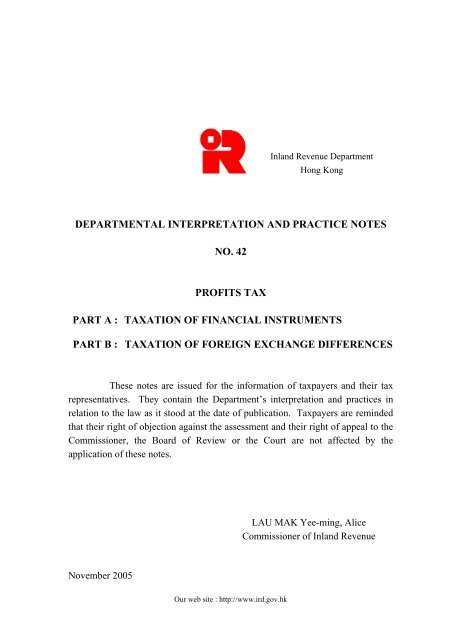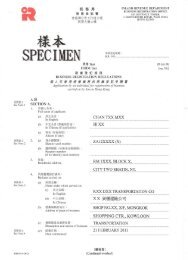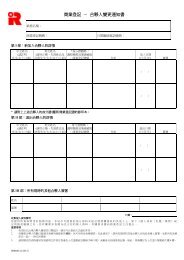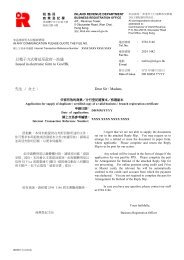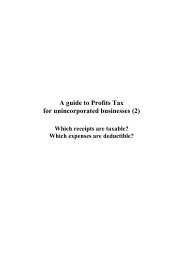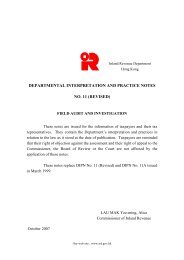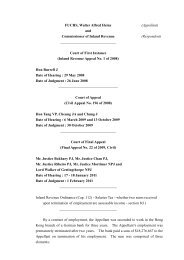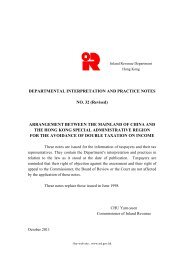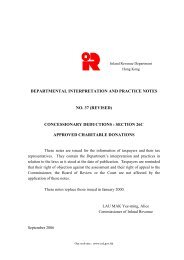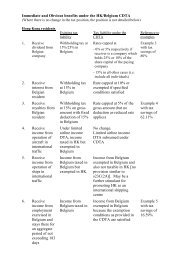Departmental Interpretation And Practice Notes - No.42
Departmental Interpretation And Practice Notes - No.42
Departmental Interpretation And Practice Notes - No.42
Create successful ePaper yourself
Turn your PDF publications into a flip-book with our unique Google optimized e-Paper software.
(a)“Financial assets or financial liabilities at fair value throughprofit or loss” are :-(i)financial assets acquired and financial liabilities incurredfor the purpose of trading and all derivatives that are nothedges; or(ii) those financial assets or financial liabilities designatedby the entity as at fair value through profit or loss uponinitial recognition.They are measured at fair value with all resulting gains andlosses recognised in the profit and loss account as and whenthey arise.(b)(c)(d)“Held-to-maturity investments” are non-derivative financialassets with fixed or determinable payments and fixed maturitythat an entity has the positive intention and ability to hold tomaturity. They are accounted for at amortised cost. Profitsor losses are recognised upon impairment, derecognition orthrough amortisation.“Loans and receivables” are non-derivative financial assetswith fixed or determinable payments that are not quoted in anactive market. They are accounted for at amortised cost.Profits or losses are recognised upon impairment,derecognition or through amortisation.“Available-for-sale financial assets” are those non-derivativefinancial assets that are designated as available for sale or arenot classified as above. They are measured at fair value withall resulting gains and losses taken to the equity accountinstead of the profit and loss account. On disposal, gains orlosses previously taken to the equity account are recycled ortransferred to the profit and loss account.9. It should be pointed out that the above accounting classifications donot necessarily determine whether the financial assets or financial liabilities arecapital or revenue in nature.4
ASSESSING PRACTICEThe issues10. Pursuant to section 14(1), only profits arising in or derived fromHong Kong are chargeable to profits tax and profits arising from the sale ofcapital assets are not taxable. In the context of financial instruments, thefollowing issues need to be examined:-(a)(b)(c)(d)(e)(f)(g)(h)Timing of assessmentLegal form and economic substanceCapital v revenue nature of the incomeDeduction of expensesLocality of profitsHedge accountingEmbedded derivativesTransitional adjustmentsTiming of assessment11. Under HKAS 39, when a financial asset or financial liability isrecognised initially, an entity shall measure it at its fair value. In the case of afinancial asset or financial liability not at fair value through profit or loss,transaction costs that are directly attributable to the acquisition or issue of thefinancial asset or financial liability should be added to the fair value. The“fair value” is the amount for which an asset could be exchanged, or a liabilitysettled, between knowledgeable, willing parties in an arm’s length transaction.12. After initial recognition, HKAS 39 requires an entity to measure:-(a)“Financial assets at fair value through profit or loss”, includingderivatives that are assets, and “available-for-sale financialassets” at their fair values without any deduction for transactioncosts it may incur on sale or other disposal;5
(b) “Loans and receivables” at amortised cost using the effectiveinterest method;(c)(d)“Held-to-maturity investments” at amortised cost using theeffective interest method; and“Financial liabilities” at amortised cost, except for financialliabilities at fair value through profit or loss which aremeasured at fair value.Financial assets designated as hedged items are subject to measurement underthe hedge accounting requirements (see paragraphs 34 to 40 below).13. On the whole, the Department will follow the accounting treatmentstipulated in HKAS 39 in the recognition of profits or losses in respect offinancial assets of revenue nature (see paragraphs 23 to 26). Accordingly, forfinancial assets or financial liabilities at fair value through profit or loss, thechange in fair value is assessed or allowed when the change is taken to theprofit and loss account. For available-for-sale financial assets, the change infair value that is taken to the equity account is not taxable or deductible untilthe assets are disposed of. The cumulative change in fair value is assessed ordeducted when it is recognised in the profit and loss account in the year ofdisposal. For loans and receivables and held-to-maturity investments, the gainor loss is taxable or deductible when the financial asset is derecognised orimpaired and through the amortisation process. Valuation methods previouslypermitted for financial instruments, such as the lower of cost or net realisablevalue basis, will not be accepted.Example 1Company A is a securities trading company incorporated in HongKong. It closes its books on 31 December each year. At thebeginning of 2005, it purchased by way of subscription a mediumterm note due 2008 issued by the treasury arm of a listed company.The note has a face value of $100,000 and an interest of 8 per centper annum payable at year end. Assuming at the end of 2005, thefair value of the note is $110,000 indicating that the market interestrate has fallen. On 31 December 2005, in accordance with HKAS39, the following journal entries should be made:-6
issuer company (e.g. voting rights and rights on winding-up), the existence of adebtor and creditor relationship and the characterisation of the instrument bygeneral law.Example 2Company B, a company registered under the Companies Ordinance,issued preference shares with a par value of $100 million and adividend of 10 per cent per annum. Puttable options attached to thepreference shares permit the redemption of the instruments for cash.The holders have rights to attend members meetings, to receivenotices of general meetings and to approve resolutions. Thedirectors can omit the dividend without throwing the company intobankruptcy.Though the preference shares are accounted for as financial liabilitiesand the dividends declared are charged as interest expenses to theprofit and loss account under HKAS 32, the preference shares will betreated for tax purposes as share capital because the relationshipbetween the holders and the company is not a debtor and creditorrelationship. Dividends declared will not be allowed for deductionas interest expenses and will not be assessed as interest income.22. HKAS 32 requires the issuer of a compound financial instrument tosplit the instrument into a liability component and an equity component andpresent them separately in the balance sheet. The Department, whilerecognising that the accounting treatment might reflect the economic substance,will adhere to the legal form of the compound financial instrument and treat thecompound financial instrument for tax purposes as a whole.Example 3Company C issued 2,000 convertible bonds each having a face valueof $1,000,000 with a five-year term and an annual interest rate of 10per cent. At any time up to maturity, each bond can be convertedinto 250,000 ordinary shares. The terms of issue provide for amonetary settlement of bonds that have not been converted intoordinary shares.10
Though in the accounts of Company C, the convertible bonds aresplit in accordance with HKAS 32 into equity components and debtcomponents, they will be treated as debts because the companystands in the position of debtor of a money debt and the subordinateright to convert need not be exercised. Interest payments will beallowed for deduction if the conditions in section 16 are satisfied.Capital / Revenue nature of the income23. Profits arising from the sale of capital assets are excluded from thecharge of profits tax. Capital profits or losses, if any, recognised in the profitand loss account will be excluded from the computation of assessable profits.The accounting treatment, by itself, cannot operate to change the character ofan asset from investment to trading and vice versa. Whether the asset is ofcapital or revenue nature is a question of fact and degree and all thesurrounding circumstances, including the accounting treatment, have to beconsidered. Well-established tax-principles like the “badges of trade” willcontinue to be applicable. In deciding whether a financial instrument is acapital or trading asset, the intention at the time of acquisition of the financialinstrument is always relevant.24. By definition, a financial asset or financial liability at fair valuethrough profit or loss includes a financial asset or financial liability that is heldfor trading. It is classified as trading if it is acquired or incurred principallyfor the purpose of selling or repurchasing; or there is a pattern of short-termprofit-taking. Typically, unless it is a designated and effective hedginginstrument, a derivative will be classified as held for trading. Thus, thechange in fair value and the gain or loss on disposal, recognised in the profitand loss account, are prima facie taxable or deductible as the case may be.25. Normally, loans and receivables, held-to-maturity investments andavailable-for-sale financial assets are trading assets where the taxpayer is afinancial institution or it carries on an insurance, money lending, securitiesdealing or finance business because financial assets are often acquired in thecourse of the business with a view to resale at a profit. In CIR v. SincereInsurance & Investment Co Ltd, 1 HKTC 602, the disposal of leaseholdproperties was held to be part of the normal business of an insurance company.11
26. It should be noted there are specific provisions that apply toparticular types of financial instruments. Section 14A provides that interestfrom and gains or profits from the sale, disposal or redemption on maturity orpresentment of “qualifying debt instruments” will be assessed at half rate.Section 15(1)(j), (k) and (l) deem as chargeable receipts gains or profits fromthe sale, disposal or redemption on maturity or presentment of “certificates ofdeposit” and “bills of exchange”. Section 26A excludes interest and profitsderived from certain financial instruments from profits tax. The taxability ofthe sums stipulated in aforesaid legislative provisions should not be affected bythe accounting practice under HKAS 39.Deduction of expenses27. For the purpose of ascertaining profits in respect of which a person ischargeable to profits tax, section 17(1)(c) provides that no deduction shall beallowed in respect of any expenditure of a capital nature or any loss orwithdrawal of capital. HKAS 39 in this respect does not prescribe any rulesfor distinguishing capital and revenue expenditures. Whether the expenditureis capital or revenue in nature is a question of law. The accounting treatmentwill not determine the nature of the expenditure.28. In deciding the nature of an expenditure, capital or revenue, it isnecessary to examine the facts and the circumstances. Where the expenditureis a one-off payment that brings into existence an asset or advantage for theenduring benefit of the trade, it is likely to be a capital expenditure. In SunNewspaper Ltd v. FCT, [1938] 1 AITR 403, Dixon J observed at page 410 thatexpenditure was of a capital nature if its purpose was to establish, replace, orenlarge the capital structure of the taxpayer’s business. In contrast, recurrentexpenses connected with the process of operating it are generally considered tobe revenue in nature.29. In CIR v. Tai On Machinery Works Ltd, 1 HKTC 411, McMullin J,after referring to the textbook Spicer and Pegler, held that interest payments ona loan to finance the construction of a building which was a capital asset werenon-deductible payments of a capital nature to the extent that the paymentswere made before the building could be used to produce profits. In WharfProperties Ltd v. CIR, 4 HKTC 310, Lord Hoffmann at the Privy Council saidwhether interest payment was of a capital or revenue nature depended on the12
purpose for which the money was required during the relevant period. In FCTv. Energy Resources of Australia, 29 ATR 553, the Australian Federal Courtobserved that in some circumstances a discount expense incurred by the issuerof a discount note may be loss of a capital nature.Example 4Company D is an importer and exporter of household wares. Ithas made a forward purchase £1,000,000 that relates to the futurepayment of the purchase price of machinery acquired for use in itsbusiness. The currency forward contract is clearly for the purposeof hedging against the foreign currency risk arising from thepurchase of the machinery and Company D consistently adopts abasis adjustment.The nature of the gain or loss arising from the currency forwardcontract depends on the nature of the underlying asset. Thus thegain or loss from the currency forward contract will be capital innature. It will be taken into account in determining the capitalexpenditure incurred on the provision of the machinery fordepreciation allowances purposes. Such gain or loss will similarlybe taken into account for depreciation allowances purposes if thecompany does not “basis adjust” (i.e. it is simply debited or creditedto the profit and loss account).Example 5Company E is a retailer. It has entered into forward contracts tohedge against foreign exchange risks in relation to goods purchasedfrom various overseas suppliers, thus reducing fluctuations in thecosts of its inventory.Profits and losses from the forward contracts will be taken intoaccount as part of the profits and losses of the trade because theyrelate closely to the purchase of the inventory.13
Example 6Company F has borrowed money at a floating rate of interest forpurchase of trading stock and enters into an interest rate futurescontract with a view to protecting itself against rises in interestrates.Profits and losses relating to the interest rate futures contract will betaken into account as trading income or expenditure because theinterest rate futures contract closely relates to money borrowed onrevenue account for the purchase of trading stock.30. HKAS 39 contains rules governing the determination of impairmentlosses. In short, all financial assets must be evaluated for impairment exceptfor those measured at fair value through profit or loss. As a result, thecarrying amount of loans and receivables should have reflected the bad debtsand estimated doubtful debts. However, since section 16(1)(d) lays downspecific provisions for the deduction of bad debts and estimated doubtful debts,the statutory tests for deduction of bad debts and estimated doubtful debts willapply. Impairment losses on other financial assets (e.g. bonds acquired by atrader) will be considered for deduction in the normal way.31. It should be noted that under a pass-through arrangement whereby anobligation to transfer the cash flows from the financial asset is assumed and thefinancial asset has been derecognised, it does not necessarily follow that theinterest payments included in the cash outflows have fulfilled the conditions insection 16(2).Example 7Company G and Company H are carrying on business in Hong Kong.They are not connected. Company H advanced an interest bearingloan of $100 million to Company G. Company H funded itsadvances to Company G with a non-recourse loan from Company I,which is a company operating outside Hong Kong. Company Hdoes not earn an interest spread and is only required to makepayments of interest and repayments of principal out of the cashflows it receives from Company G. There is no assignment of the14
loan or of the cash flows by Company H. Under the abovearrangement, Company H has neither any risk nor reward. Thusunder HKAS 39 Company H has derecognised from its accounts theadvance to Company G and the non-recourse loan from Company I.Though Company H has derecognised the loan in its accounts, theinterest payments made by Company H to Company I will be denieddeduction under section 16(2)(c) because Company I is notchargeable to profits tax in respect of the interest income it receives.The interest received by Company H from Company G remainschargeable to tax under section 14 alone or in conjunction withsection 15(1)(f) depending on the facts of the case. In law,Company H remains entitled to collect interest from Company G.Company G can claim deduction for the interest paid to Company H.Example 8Locality of profitsSame facts as in Example 7. Assume Company G and Company Iare connected.The interest payments made by Company G to Company H will bedenied deduction under section 16(2B).32. The ascertainment of the source of an income is a practical, hardmatter of fact. No simple, single, legal test can be employed. However,there is a substantial body of case law on the determination of the locality ofprofits. The broad guiding principle is to look at what the taxpayer has doneto earn the profit in question and where he has done it. The Department hasset out its views on the locality of profits in <strong>Departmental</strong> <strong>Interpretation</strong> &<strong>Practice</strong> <strong>Notes</strong> No. 21. The general principle of law in this area is not affectedby the accounting practice under HKAS 39.33. It should be noted that section 15(1)(l) deems as chargeable profitsgains or profits from the sale, disposal or redemption of certificates of depositor bills of exchange through or from the business of a financial institutionnotwithstanding the moneys for the acquisition were made outside Hong Kongor the sale, disposal or redemption is effected outside Hong Kong.15
Hedge accounting34. Hedge accounting is an exception to the usual rules used foraccounting of financial instruments. Application of hedge accounting ispermitted under HKAS 39 if strict criteria (see paragraph 36) are met. Hedgeaccounting means designating a hedging instrument, normally a derivative, asan offset to changes in the fair value or cash flows of the hedged item whichcan be an asset, liability, firm commitment or forecasted future transactionexposed to a risk of change in value or changes in future cash flows. Hedgeaccounting matches the offsetting effects of the fair value changes in thehedged item and the hedging instrument. If the hedging relationship comes toan end, hedge accounting must be discontinued prospectively.35. Hedging relationships are of three types:-(a)“Fair value hedge” is a hedge of the exposure to changes in fairvalue of a recognised asset or liability or an unrecognised firmcommitment, or an identified portion of such an asset, liabilityor firm commitment, that is attributable to a particular risk andcould affect profit or loss.(b) “Cash flow hedge” is a hedge of the exposure to variability incash flows that is attributable to a particular risk associatedwith a recognised asset or liability or a highly probable forecasttransaction and could affect profit or loss.(c)“Hedge of a net investment” in a foreign operation is a hedgeof the interest in the net assets of that operation.36. As a result of HKAS 39, a hedging relationship qualifies for hedgeaccounting if, and only if, all of the following conditions are met:-(a)At the inception there is formal designation and documentationof the hedging relationship and the entity’s risk managementobjective and strategy.(b) The hedge is expected to be highly effective in achievingoffsetting changes in fair value or cash flows attributable to thehedged risk.16
(c)(d)For cash flow hedges, a forecast transaction that is the subjectof the hedge must be highly probable and must present anexposure to variations in cash flows that could ultimately affectprofit or loss.The effectiveness of the hedge can be reliably measured.(e) The hedge is assessed on an ongoing basis and determinedactually to have been highly effective.37. In a fair value hedge, the profit or loss from remeasuring the hedginginstrument is recognised immediately in the profit and loss account. At thesame time, the carrying amount of the hedged item is adjusted and the changeis also recognised immediately in the profit and loss account. In a cash flowhedge, the portion of the profit or loss on the hedging instrument that is aneffective hedge is recognised directly in equity and is recycled to the profit andloss account when the hedged cash flows affect the profit. In other words, inthese types of hedges, only the net result is shown in the profit and loss account.Any hedge ineffectiveness, even if the hedge continues to be effective overall,is recognised in the profit and loss account of the current period. As apractice, the Department considers that the tax treatment should follow theabove accounting treatment of the hedging relationship.38. If the hedging relationship qualifies for hedge accounting underHKAS 39 and is accounted for as such, the Department considers that thehedged item and the hedging instrument should not be considered separatelybecause hedging is an attempt to mitigate the impact of economic risks of thehedged items. A distinct locality should not be imputed on to the hedginginstrument and the locality of the hedging instrument should follow that of thehedged item. Regarding the nature of the profit or loss, capital or revenue,arising from the hedging instrument, the Department accepts that it depends onthe nature of the hedged item.39. Hedge accounting will not occur in any one of the followingsituations even though a hedge exists:-(a) the hedge relationship fails to satisfy the conditions inparagraph 36 above;17
(b) the hedge relationship satisfies the conditions in paragraph 36above but hedge accounting is not adopted; or(c) hedge accounting is discontinued because the hedge becomesineffective.In the absence of hedge accounting, the hedging instrument and the hedgeditem are accounted for separately in the accounts. It follows that the changesin their values are not set off against each other. The tax treatments for thehedging instrument and the hedged item are therefore considered separatelyunless the hedging instrument is as a matter of fact a hedge against the hedgeditem even though hedge accounting is not or cannot be adopted. That mayoccur for example in the case of a small business where documentation is notproperly done. In such situations, the tax treatment of the hedging instrumentand the hedged item may not necessarily be considered separately even thoughthey are accounted for separately in the accounts. The facts andcircumstances of each individual case have to be examined to determinewhether the hedging instrument is really a hedge against the hedged item andshould be treated together with the hedged item as a whole.40. Enterprises sometimes control their group financial activities througha central treasury unit that trades with external third parties. This avoids asubsidiary having to go directly to the market to find a hedge. The usualpractice is for the central treasury unit to execute a hedge with an external thirdparty and that the terms and conditions of that hedge are passed on to thesubsidiary through an internal hedge. An internal hedge will normally not beaccepted unless there is a corresponding external hedge because an internalhedge will be eliminated on consolidation and will not achieve any commercialresults for the group as a whole. It is recognised and accepted that the nettingof exposures within a group on an arm’s length basis by the treasury unit ispossible. However, the taking of any net exposure would require a factualbasis and would suggest that the central treasury unit is trading in derivatives.Often a group treasury company would not be taking any position ofsignificance. In short, the Department holds the view that hedge accountingshould normally be available to those internal or centralised hedging activitieswith “matched external transactions” that are entered into on a one for onebasis.18
Example 9Company J is buying and selling commodities (e.g. metals). Thecommodities are purchased from suppliers located in Australia andsold to enterprises located in the Mainland. The profits from thecommodity trade are fully assessable to profits tax. To guaranteethe sales prices of the commodities, Company J is to short futurescontracts on the commodities with appropriate settlement dates onan overseas exchange. The futures contracts qualify for hedgeaccounting and are accounted for as such.The locality and nature of the commodity futures follow those of theunderlying onshore trading transactions. The commodity futuresare ancillary to the trading transactions and the intention is not tospeculate in commodity futures.Example 10Company K whose base currency is the Hong Kong dollar, carryingon a garment trading business in Hong Kong, held as investmentyen-denominated shares listed on the Tokyo Stock Exchange and inorder to eliminate the perceived risk of a fall in their value, enteredinto a forward contract with a local financial institution to sell forHong Kong dollars an amount of yen equivalent to the yen value ofthe shares. The forward contract qualifies for hedge accountingand is accounted for as such.The forward contract and the shares will be given similar taxtreatment because the forward contract is regarded as ancillary to theoffshore capital transaction in shares. The forward contract inessence was part and parcel of an offshore investment.Embedded derivatives41. An embedded derivative is a component of a hybrid instrument thatcontains a non-derivative host contract. Embedded derivatives can be foundin a number of financial instruments, including put options in bonds, callablebonds, put options on preference shares etc. In legal form, a hybridinstrument is one single instrument. Accordingly, for accounting purposes,19
the embedded derivative and the host contract are not separated. This was thesituation before HKAS 39. However, under HKAS 39, an embeddedderivative is now required to be separated from the host contract if:-(a)the hybrid instrument is not recorded at fair value with profitsor losses taken to profit and loss account;(b) a separate instrument with the same terms as the embeddedderivative would meet the definition of a derivative; and(c)the economic characteristics and risks of the embeddedderivative are not closely related to the economiccharacteristics and risks of the host contract.42. For tax purposes, the nature (i.e. capital or revenue) and locality ofprofit and loss of the hybrid instrument are determined on the basis that it isone single instrument. In other words, the nature and locality of profit andloss arising from the embedded derivative and the host contract should alwaysbe the same. Under HKAS 39, the embedded derivative and the host contractare required to be separated under certain circumstances. However,notwithstanding such change in accounting requirement, the same tax treatmentwill be applied because in its legal form the hybrid instrument is still one singleinstrument.43. Where the embedded derivative has been separated from the hostcontract and the accounting treatments of changes in the carrying amounts ofthe embedded derivative and the host contract differ, the Department so far astiming of assessment is concerned is prepared to accept the accountingtreatment under HKAS 39 as the tax treatment. The Department does notaccept that the entire gain will only be taxed in the year the hybrid instrumentis sold.Transitional adjustments44. HKAS 39 itself prescribes the transitional adjustments for tradingfinancial assets or liabilities when a taxpayer first adopts HKAS 39.According to HKAS 39, the cumulative change in fair value of the tradingfinancial assets or liabilities in the periods prior to the adoption of HKAS 3920
should be accounted for by adjusting the opening balance of retained earnings,i.e. a prior period adjustment.45. The Department considers that a prior period adjustment for thetrading financial asset or liability should be treated as a taxable receipt for anincrease in retained profits or a deductible expense for a decrease in retainedprofits in the year of assessment in which the prior period adjustment isrecognised in the retained earning. This view is supported by the case ofPearse v. Woodall-Duckhall Ltd, [1978] 51 TC 271. In that case, a taxpayerchanged the basis of valuing its work-in-progress in 1969 and included thesurplus on revaluation in the profit and loss appropriation account.Templeman J held that the “anticipated profit for work carried out prior to 1969falls to be taxed in the year 1969 when it is first revealed and first brought intoaccount”.Example 11Company L is a money lender. Prior to 1 January 2005, it did notrecord its currency swap agreements and interest rate swapagreements in its balance sheet. On 1 January 2005, Company Lafter ascertaining the fair value of the unexpired agreementsrecognised a profit of $500,000 which it credited to its retainedprofits as a prior period adjustment.The prior period adjustment of $500,000 relates to trading financialassets and should be treated as a taxable receipt in the year ofassessment in which the prior period adjustment is recognised, i.e.year of assessment 2005/06.46. In the case of available-for-sale financial assets, according to HKAS39, on its first adoption, all cumulative changes in fair value of such assets inthe prior periods should be recognised in the equity account. On subsequentdisposal, the cumulative gain or loss previously taken to the equity account istransferred to the profit or loss account. The Department would accept thatthe cumulative change in fair value is taxable or deductible, as the case may be,in the year in which it is eventually transferred to the profit and loss account,i.e. not in the year of first adoption of HKAS 39. This practice would applyonly if the assets are of a revenue nature.21
ANTI-AVOIDANCE47. It has to be emphasised that when tackling transactions to avoid tax,the Assistant Commissioner is prepared to invoke the powers in section 61A torecharacterise a financial transaction, including reclassification of the nature ofthe financial instrument and the nature of the income or expense, so as tocounteract tax benefits obtained by the relevant person or persons who enteredinto or carried out the financial transaction for the sole or dominant purpose ofobtaining such tax benefits.EFFECTIVE DATE48. HKAS 32 and HKAS 39 are applicable for annual periods beginningon or after 1 January 2005. The aforementioned assessing practices will applystarting from the year of assessment 2005/06.22
PART B: TAXATION OF FOREIGN EXCHANGE DIFFERENCESBACKGROUNDAccounting practice49. Business concerns may carry out transactions as a result of whichthey receive or make payments in foreign currency. The circumstances mayvary considerably; foreign currencies received may be converted into HongKong dollars immediately or after a lapse of time; or the concern’s accountsmay be kept in foreign currency. At the same time, they may carry outtransactions or hold assets or liabilities denominated in foreign currencies. Inpreparing the annual accounts, translation of the foreign currency transactionsare necessary. HKAS 21 deals with the effects of changes in foreignexchange rates and has replaced SSAP 11 with effect from 1 January 2005.50. Under HKAS 21, a foreign currency transaction is to be recorded oninitial recognition in the functional currency, by applying to the foreigncurrency amount the spot exchange rate between the functional currency andthe foreign currency at the date of the transaction. At each balance sheet date,foreign currency monetary items shall be translated using the closing rate;non-monetary items that are measured in terms of historical cost in a foreigncurrency shall be translated using the exchange rate at the date of thetransaction; and non-monetary items that are measured at fair value in a foreigncurrency shall be translated using the exchange rates at the date when the fairvalue was determined.51. Exchange differences arising on the settlement of monetary items oron translating monetary items at rates different from those at which they weretranslated on initial recognition during the period or in previous financialstatements will normally be recognised in profit or loss in the period in whichthey arise.Overview of the case law52. While HKAS 21 has laid down the factors for determining thefunctional currency of an entity, the Department accepts that a foreigncompany may maintain its Hong Kong Branch accounts in its home country23
currency. For tax purposes, however, its assessable profits or losses for eachyear must be expressed in Hong Kong dollar terms (CIR v. Malaysian AirlineSystem Berhad, 3 HKTC 775).53. Exchange gains or losses are neither taxable nor allowable if they areof a capital nature. In CIR v. General Garment Manufactory (Hong Kong) Ltd,4 HKTC 532, the exchange loss was found deductible because, notwithstandingthe Board’s limited analysis, the intention at the time of acquisition of theforeign currency was to dispose of it quickly for profit, not to acquire apermanent investment. In CIR v. Li & Fung, 1 HKTC 1193, Garcia J held inthe High Court that although the sums in question originated as trading incomethe exchange loss was not deductible because their nature was altered to that ofcapital investment when accumulated and placed on deposits over time.54. Whether a borrowing is on capital account or revenue account is aquestion of law to be determined on the facts of each particular case. A gainor loss of fixed capital is an item on capital account, while a gain or loss ofcirculating capital is an item on revenue account. In Avco Financial ServicesLtd v. FCT, [1982] 13 ATR 63, it was held that exchange losses incurred inrespect of funds borrowed by a person who carried on business of borrowingand lending money or dealing in foreign exchange were inherently on revenueaccount unless the funds were used to strengthen that person’s profit-makingcapital base. In the case of an ordinary trading company, loans are on revenueaccount if they are temporarily fluctuating and incurred in meeting the ordinaryrunning expenses of the business. In CIR v. Chinachem Finance Co Ltd, 3HKTC 529, it was held at the High Court that in deciding whether a loss arisingfrom borrowing was made on capital or revenue account, regard must be madeto the length and other terms of borrowing and to the nature of the person’strade.55. Exchange gains or losses arising in or derived outside Hong Kongare neither taxable nor allowable. Normally, exchange differences arisingfrom capital investment in a “foreign operation” as defined in HKAS 21 shouldnot have any effect on the assessable profits.24
ASSESSING PRACTICE<strong>Practice</strong> before Secan56. In the case of financial institutions, the assessing practice beforeSecan was that the exchange gains or losses recognised in the profit and lossaccounts in accordance with accounting practice were assessed or allowed fordeduction. There had been no argument on the question of taxing unrealisedexchange gain or allowing unrealised losses.57. However, other taxpayers recognised the gains or losses in theprofit and loss account but excluded them in the tax computation due tounrealisation. It had long been the Department’s practice to accept thetaxpayer’s tax computation provided that the treatment was followedconsistently and that subsequent adjustment was made upon realisation.Reasons for change58. Following the general principle laid down by the Court of FinalAppeal in the Secan case that assessable profits must be ascertained inaccordance with the ordinary principles of commercial accounting, theDepartment has reviewed the practice in paragraph 57 above and decided tocease this practice. In other words, all taxpayers including financialinstitutions should treat exchange gains or losses recognised in the profit andloss account, whether realised or not, as taxable receipts or deductible expenses.An adjustment in the tax computation on the ground that an exchangedifference has not yet realised will not be accepted.59. As noted above, the Secan case requires the tax treatment to followthe accounting treatment. This principle applies to financial instruments. Thereis no reason why it should not be applied to exchange gains or losses as well.The Department considers that the change of practice brings about a taxtreatment of exchange gains and losses that is consistent with the treatment ofother types of income and expenses.Example 12Company M is carrying on an import and export business in Hong25
Kong. It makes up its accounts to 31 December each year. On 31October 2005, it sold goods at a price of €10,000 to a customer inGermany. The exchange rate at the time of sale was €1 = $9. Areceivable of $90,000 shows up in the accounts. Assuming that asat 31 December 2005, the exchange rate is €1 = $10, the journalentries at year end will be:-Account Debit Credit$ $Receivable 10,000Profit & loss - exchange gain 10,000The exchange gain of $10,000 will be assessable profit of the year ofassessment 2005/06.60. The new practice is similar to the approach of the UK Revenue oftaxing or allowing unrealised exchange differences. The following is anextract from its Business Income Manual BIM 39510 on this topic:“(Finance Act 1998) requires Case I profits to be computed inaccordance with generally accepted accounting practice, subject toany over-riding rule of law. So in general a business must bringinto its Case I computation all exchange gains and losses shown inits accounts, whether realised or unrealised, provided that theyconform to the general principles (of taxability and deductibility).”(Emphasis added.)EFFECTIVE DATE61. The revised practice will be applied by the Department to anyforeign exchange differences for the year of assessment 2005/06 andsubsequent years. Accordingly, taxpayers and their representatives shouldadopt the revised practice in the preparation of profits tax returns for theseyears of assessment. Where an unrealised exchange difference has beenexcluded from the tax computation in an earlier year of assessment, it should beadjusted in the tax computation for the year 2005/06.26


